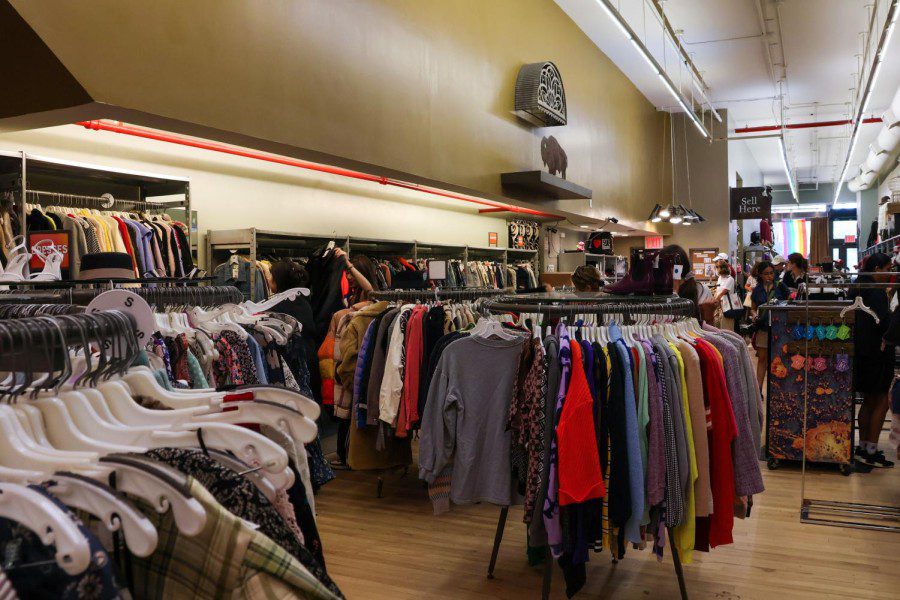Les Miss wants to be a ‘true‘ thrift store
As thrifting takes over the fashion world and Manhattan stores are popularized by social media, prices have risen sharply even as some stores are seeing a decrease in quality.
File photo: Since the rise of thrifting as a cultural trend, thrift stores have had trouble discerning between good, quality clothing and fast fashion. (Yuna Baek for WSN)
October 4, 2022
Young wardrobe stylist Sam Deutsch answered his phone as he took a new electric Citi Bike for a cruise down First Avenue in the East Village. When the pandemic began, Deutsch left school to pursue a career in fashion, dressing models for shoots and scouring Manhattan for the best garments. A resident of the Lower East Side for all twenty years of his life, Deutsch has seen his neighborhood change in many ways. None was as shocking as the drastic change in the thrifting landscape.
“I have been thrifting in New York City since well before TikTok popularized it,” Deutsch said. “It feels like the consumption of thrifted, secondhand, vintage… or whatever you want to call it, has increased significantly in the last three years.”
Deutsch’s observations are accurate. The market for secondhand clothing has become a worldwide phenomenon, growing three times as fast as the global apparel market. Americans, particularly New Yorkers, have flocked to a variety of stores in search of that one-of-a-kind clothing item that isn’t for sale at the classic department or retail store. One can thrift anywhere, whether it’s searching the bins of a local Goodwill or sifting through the semi-curated racks of L Train Vintage, an East Village and Brooklyn business with a cult following amongst NYU students. But as the popularity of secondhand clothing rises, prices have begun to rise as well.
“I used to be able to go into stores like L Train and pick up a nice button-down shirt for ten dollars, but I recently went in and saw poorer quality fast fashion marked up for twenty to forty dollars,” Deutsch said.
There is something to be said about New York’s newfound love of secondhand clothing and its contribution to reducing fashion’s carbon footprint. However, the once fast-fashion-free zones of thrifting have become inundated with microtrends formulated by brands like Zara and H&M.
There are many concerns about thrift stores becoming more “self-aware,” as Deutsch puts it. The thrifting boom has enabled thrift stores to take advantage of these new customers with deeper pockets, knowing that they are willing to pay more than the average buyer five years ago.
“Some stores no longer put out unique pieces,” Deutsch said. “Now they put out what they think people want, which defeats the freedom of thrifting from the retail markets.”
As more people donate their fast fashion finds, many thrift stores are overwhelmed, struggling to sort through the clothing to distinguish vintage pieces from secondhand, low-quality retail pieces. Compared to listings in the year 2020, online consignment store thredUp saw a 186% increase in clothing by fast fashion brand Shein, signaling the decline in the quality of the market.
Increases in price and decreases in quality are symptoms of overshopping by those who are interested in getting a haul, rather than those looking for retail-alternative clothing. Because thrift stores are experiencing this influx of shoppers new to thrifting and prone to overconsumption, those who rely on affordable clothing are left in a bind.
If thrifting in New York City is changing, there must be those who are steadfast in keeping high-quality garments at a traditionally low price, right? This question is becoming harder to answer. It seems that there are two dissenting factions within the new status quo of thrifting. On the one hand, you have the rare stores that Deutsch says are still “true thrifts,” like East Village Thrift Shop, offering cheap, quality garments free from the overcrowding of its Manhattan peers. Then there are stores like Les Miss NYC in Nolita that offer upcycled, handmade garments.
Founded by 2020 Gallatin graduate Leah Gans, Les Miss is a women’s store that offers sustainably designed clothing that takes a more progressive path amid the thrifting market.
Upon entering Les Miss’ Mott Street store, I was immediately greeted with an array of bright garments, a carefully curated selection of handmade clothing, and personally designed options. Gallatin senior and employee at Les Miss Daniella Arcila had a lot to say about what Les Miss offers in comparison to other stores offering vintage or upcycled clothing.
“For us, it’s about actually caring about fashion and not just making a profit off of vintage pieces that were found at a lower price,” Arcila said. “Our prices reflect the work put into sourcing and redesigning goods.”
She showed me one example of these revived pieces, a pair of old Levi’s jeans that had been sewn with new fabrics and designs to accent the vintage look.
“The idea in a lot of our clothing is to take thrifted goods that may not get any attention and give it a new life,” Arcila said.
Les Miss was a far cry from the East Village stores I explored earlier in the day. I was pleasantly surprised by its subtleties in floor design and its ability to lead the shopper to the next rack or table, compared to the piles of clothes in traditional thrift stores. Les Miss exemplifies the variety in secondhand clothing that has emerged as a result of the market’s boom, preserving the quality and creativity that initially sparked the interest of millions of new shoppers.
As the secondhand clothing market booms and TikTok familiarizes audiences worldwide with New York City’s fashion culture, will our city’s thrift stores be as authentic as they once were or will they, like much of the city, succumb to increased commercialization? After talking to both Deutsch and Arcila and touring half a dozen stores in Manhattan, it’s hard not to question what thrifting has truly become.
Contact Blake Salesin at [email protected].
























































































































































